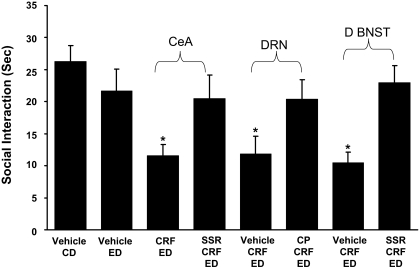Fig. 6.
CRF-1 receptor antagonist blockade of CRF-induced sensitization of ethanol withdrawal-induced anxiety-like behavior from the central amygdala, dorsal raphe, and d-BNST. A 10 mg/kg dose of the CRF-1 receptor antagonist, SSR125543 (SSR), was administered intraperitoneally 15 min before the microinjection of CRF (0.5 μg) into either the central amygdala or the d-BNST followed by the 5 days of ethanol diet. Meanwhile, another CRF-1 receptor antagonist CP154526 (CP; 10 mg/kg i.p.) was administered 15 min before each of the CRF (0.5 μg) microinjections into the dorsal raphe. See Fig. 1 for protocol. The action of CRF in these brain sites to induce sensitization of withdrawal-induced anxiety-like behavior was prevented by the CRF-1 receptor antagonist. Social interaction was measured 5 to 6 h after the ethanol diet removal. The number of rats for each group is listed in Table 1, part 4. In the CD-vehicle group and the ED-vehicle group, vehicle was administered into each of the brain sites (n = 4–6 for each site), and data were combined because a significant change across sites was not observed. No significant difference in social interaction during ethanol withdrawal (P > 0.05) was observed when the CD-vehicle group was compared with the ED-vehicle group. A representation of brain region at which CRF injections were aimed for each brain site is presented in Supplemental Material. *, P < 0.01 compared with vehicle CD- and vehicle ED-treated groups and the groups that received the SSR125543 systemically [F(7,76) = 3.005, P < 0.01].

